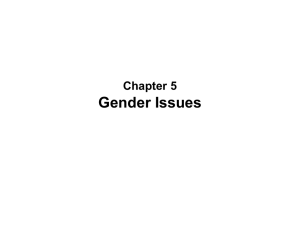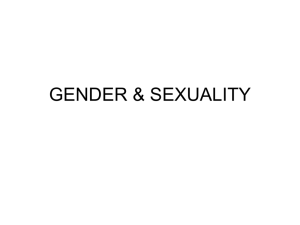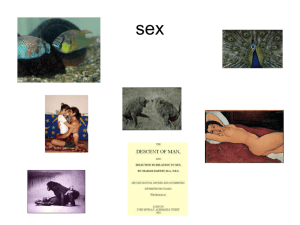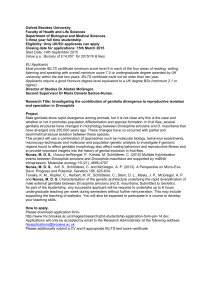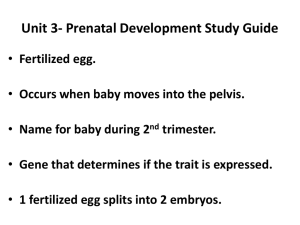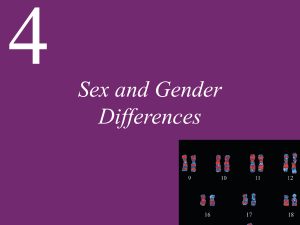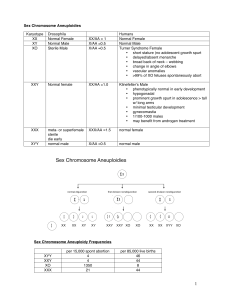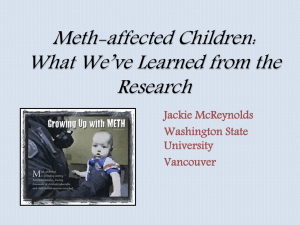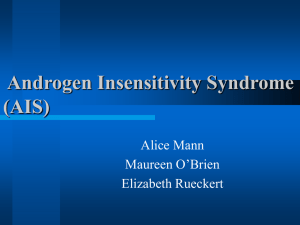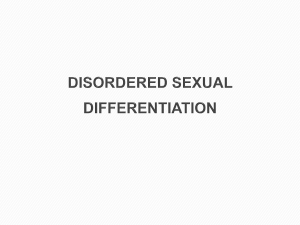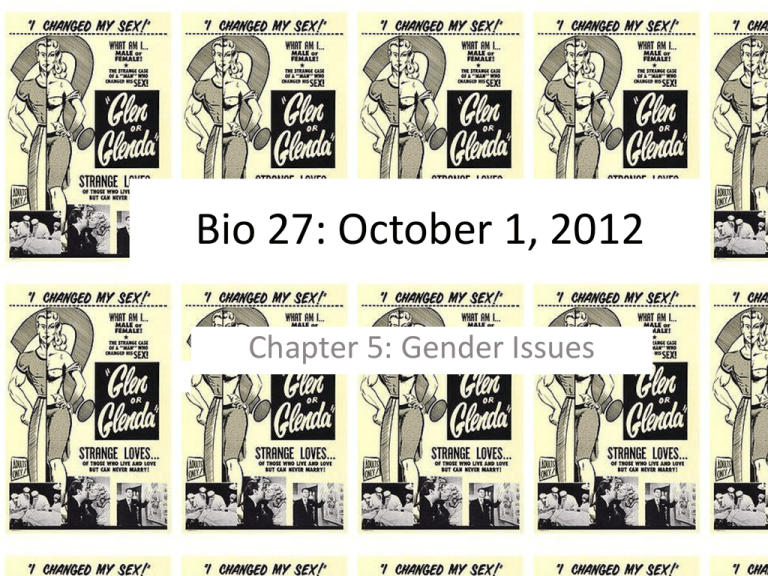
Bio 27: October 1, 2012
Chapter 5: Gender Issues
ATYPICAL PRENATAL
DIFFERENTIATION
Intersexed individuals
• Intersexed individuals are classified as:
– True hermaphrodites: have both ovarian and
testicular structures in their bodies; extremely rare!
– Pseudohermaphrodites: occurs 1 in every 2,000
births; have gonads that match chromosomal sex but
ambigulous internal and external genitalia
Atypical Prenatal Differentiation
• Sex chromosome disorders:
– Turner’s syndrome XO: 1 in every 2500–3000
females; develop typical female external genitals, but
internal genitalia and gonads are not fully developed.
Women with this syndrome do not develop breasts at
puberty or menstruate.
– Klinefelter’s syndromeXXY: 1 in every 1000 males;
develop male external genitalia, but are typically sterile
with smaller than normal penises and testes. Usually
identify as male but some have gender-identity issues
Disorders affecting prenatal hormonal processes
• Androgen
insensitivity
syndrome (AIS):
Individuals are
chromosomally male,
but due to a mutation
in their androgen
receptors develop as
females; have “blind”
vaginas and
undescended,
undeveloped testes
Disorders affecting prenatal hormonal processes
•
Fetally androgenized
females: sometimes a
female fetus will
produce high levels of
androgens as a result
of a malfunction of her
adrenal glands; these
girls are born with
masculine-appearing
genitalia and may
have gender
identification issues
Disorders affecting prenatal
hormonal processes
• DHT deficiency: some
chromosomal males cannot
make the potent androgen
DHT due to an enzyme
deficiency
• DHT plays a big role in
development of external
male genitalia, so these
individuals are born with
female external genitalia
• At puberty, high levels of
testosterone cause the
genitalia to become
masculinized
Atypical Prenatal Differentiation
GENDER ROLES AND GENDER
IDENTITY
Gender-role expectations
Margaret Mead’s studies
• Famous anthropologist
published 1963 book on three
societies in New Guinea:
– Mundumgor: both sexes
exhibited aggressive and nonnurturing behavior
– Arapesh: both sexes exhibited
gentleness and sensitivity
– Tchambuli: masculine & feminine
gender roles the opposite of
what we expect here
John Money’s studies
• Money studied intersexed
children who had been
surgically reassigned
gender (late 1960s-early
1970s)
• Found that in most cases
children whose
chromosomal and
assigned sexes did not
match developed a gender
identity consistent with
their assigned sex
Gender neutrality at birth?
• The Bradley case: another infant who lost his penis in
a similar accident was also raised as a girl. Was
tomboyish as a child and bisexual as an adult, but
maintained a female gender identity
• 25 children born without penises but otherwise
typically male were castrated after birth and raised as
girls…14 of these eventually assumed male gender
identity
• Gender neutrality at birth is now strongly questioned,
and parents of intersexed children or those with
damaged genitals are now usually advised to avoid
irreversible surgeries until their children are older
TRANSSEXUALISM AND
TRANSGENDER
Transsexualism and Transgenderism
• Transexualism: gender identity is opposite to
biological sex
• Gender dysphoria: the feeling that you are trapped
in the body of the wrong sex
• Transgendered: people whose appearance and/or
behavior does not conform to traditional gender
roles
– Spectrum of transgendered behaviors: cross-dressing, or
just having qualities of the opposite sex
• Transvestite: a person who cross-dresses to
achieve sexual arousal
Gender Identity vs. Sexual Orientation
• Before sex reassignment, most transsexuals
are attracted to people who match them
anatomically, but not in gender identity
• However, this is not always the case
• The transgendered community is more
diverse; many transvestite men are
heterosexual
Options for transsexuals
• First sex change
operations performed by
German doctors in the
1920s and 1930s
• 1960s and 1970s: these
operations became widely
available in the U.S.
• Initially many more maleto-female gender
reassignment surgeries
were performed
Sex reassignment procedures
• Individuals seeking sexual reassignment surgery
must first meet with a psychologist for screening
interviews
• They then are instructed to adopt a lifestyle
consistent with their gender identity
• Hormone therapy is then initiated:
– In men this will induce some breast growth, soften the
skin, reduce facial & body hair
– In women this will induce facial & body hair growth,
deepening of the voice, shrinkage of breasts and
cessation of menstruation
Sex change surgery
Transsexual people in the media
GENDER ROLES
Gender Roles
• Gender-based stereotypes (North American)
– Males
• Independent and aggressive
– Females
• Dependent and submissive
• Recent trend away from rigid stereotypes
– Women less entrenched than men in rigid gender-role
stereotypes
• Ethnic variation in gender roles
Gender Roles
Agents of Socialization
•
•
•
•
•
Parental expectations
Peers
School teachers and textbooks
Television and gender-based stereotypes
Religious training
Homework assignment #3: due at the
beginning of class 10/3/12
What people and other influences have
influenced your own gender role development?
Think about both positive and negative
influences that shaped your gender role. What
do you feel are the benefits and consequences
of being the gender you are?
400-700 words
“Gender is a social construct”
How strongly do you agree or disagree with this
statement? Explain your answer.
1
2
3
4
5
strongly
disagree
somewhat
disagree
neutral
somewhat
agree
strongly agree

